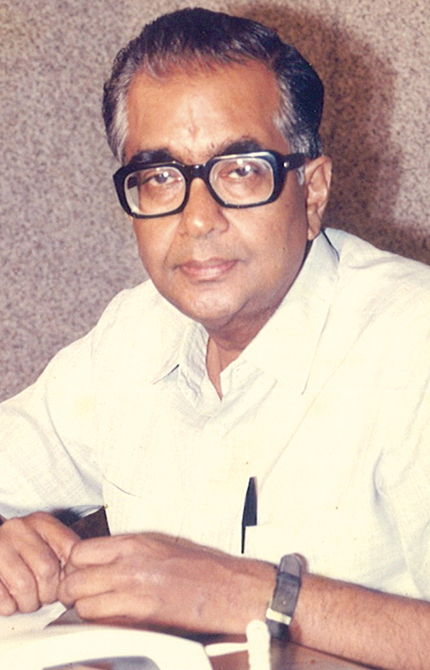C. V. Vishveshwara
DOI: 10.1063/PT.3.3635
The doyen of Indian gravitational physics, C. V. “Vishu” Vishveshwara, passed away from complications of pneumonia on 16 January 2017 in Bengaluru (formerly Bangalore), India. The “black hole man of India,” as he was called by the Indian press, will be fondly remembered not only for his seminal contributions to understanding black holes but also for the lectures, popular books, and cartoons he created to educate colleagues and the public about the consequences of Einstein’s theory of gravitation. His talks introduced generations of students to a career in science, as did his leadership at the Jawaharlal Nehru Planetarium and the Bangalore Association for Science Education.

C. V. Vishveshwara

Vishu was born on 6 March 1938 in Bangalore. He obtained a BSc in 1958 and an MSc in 1959, both from the University of Mysore. After getting his second master’s, also in physics, from Columbia University in 1964, on the advice of his mentor Robert Fuller he moved to the University of Maryland for his PhD. His 1968 dissertation, “The stability of the Schwarzschild metric,” was done under the direction of one of us (Misner).
During his time at Maryland, Vishu pursued broad interests that included literature—Hermann Hesse was a particular favorite—and judo; at the Corcoran School of Art, he took classes in drawing, a skill that he would later use to great effect in his popular talks and books. After getting his doctorate, he worked as a postdoctoral fellow and a visiting faculty member at the NASA Goddard Institute for Space Studies, New York University, Boston University, and the University of Pittsburgh before returning to Bangalore in 1976 to join the Raman Research Institute. He moved from there in December 1992 to the Indian Institute of Astrophysics, from which he retired in 2005.
Among Vishu’s early classics on black holes is an elegant 1968 paper in which he used Killing vectors to provide a coordinate-invariant distinction between the rotating Kerr and static Schwarzschild black hole solutions and the consequent existence of an entrained region, known as the ergosphere, around a rotating black hole. His thesis on black hole stability under linear perturbations was praised by theoretical physicist Brandon Carter: “Vishu was one of the first to appreciate [stability] . . . as something of potential astrophysical relevance [and provided] the first convincing proof that at least in one case, namely the Schwarzschild solution, such an equilibrium state can be stable.”
Vishu used computer simulations to explore how black holes respond when externally perturbed; he found that any deformation imparted to a black hole relaxes via the emission of gravitational waves whose frequency and decay rate depend only on the black hole mass. Those characteristic waves, later named quasi-normal modes, are like dying tones of a bell struck with a hammer. As the calculations depend critically on the boundary conditions imposed at the black hole horizon, nothing observable could probe deeper into its structure than such ringdown radiations.
Vishu’s discovery, which he published in 1970, began a new chapter in how to study black holes. Yet while he was completing his paper, NASA cut short his position at the institute because his work was on a supposedly pointless problem. He found support through Engelbert Schücking, who offered Vishu a position at New York University.
His ringdown paper was cited by the Laser Interferometer Gravitational-Wave Observatory (LIGO) and Virgo collaborations in 2016 in their first report of the detection of gravitational waves and their dynamic black hole sources; LIGO data contained the theoretical signature that Vishu had predicted 46 years earlier. Vishu was elated by the possibility that soon there would be other events where the quasi-normal modes, perhaps the most telling signature of a black hole, would be even more visible in the collision dynamics.
In his three decades at the Raman Research Institute and the Indian Institute of Astrophysics, Vishu explored various problems in classical general relativity with possible astrophysical implications. His books, including Einstein’s Enigma, or, Black Holes in My Bubble Bath (Springer, 2006), and his public lectures were inspirations to students. He would lace them with subtle humor and his cartoons.
The Jawaharlal Nehru Planetarium in Bangalore is a wonderful testament to Vishu’s vision and interest in science communication and education. As its founding director in 1988, Vishu brought together a dedicated team to build a world-class facility. In 1992 he set up the Bangalore Association for Science Education to systematically attract and mentor students from elementary schools, high schools, and colleges for a career in science.
We will miss you Vishu, even as we try very hard to follow your favorite lines from Antonio Machado: “Traveler, there is no path. Paths are made by walking.”
More about the Authors
Naresh Dadhich. Inter-University Center for Astronomy and Astrophysics, Pune, India.
Richard Isaacson. Arlington, Virginia.
Bala Iyer. International Centre for Theoretical Sciences, Bengaluru, India.
Karan Jani. Georgia Institute of Technology, Atlanta.
Charles W. Misner. University of Maryland, College Park.
